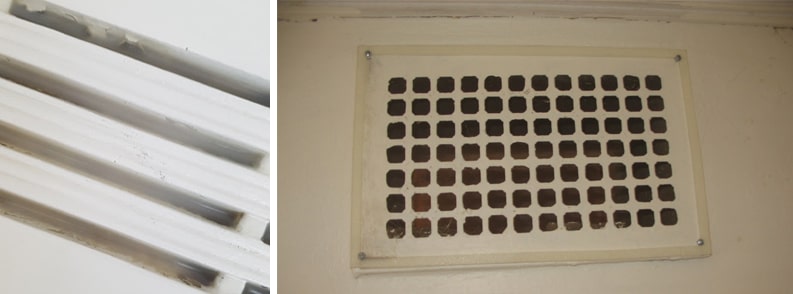
There’s a persistent myth floating around that wall vents in older homes should never be sealed. Some claim that blocking them will cause moisture issues, stop air circulation, or even create some vague, catastrophic consequence.
Let’s get this straight—that’s nonsense.
After 20+ years of draught-proofing homes and thermal efficiency retrofit, we can confidently say that indoor wall vents are outdated, unnecessary, and costing you your comfort and higher energy bills.
Here’s why it’s time to seal them once and for all.
The Truth About Wall Vents in Older Homes
- Yes, Older Homes Need Ventilation—But That’s What EXTERNAL Vents Are For
Older homes were designed to allow airflow through the walls. That’s why they have ventilation bricks or vents on the outside—to keep air moving through the wall cavities and prevent moisture buildup.
Indoor wall vents? A completely different story.
- Indoor Wall Vents Were Installed for One Reason Only—Old Heating Methods
If your home still has vents in the walls, it’s because it was built in an era when people heated their homes with wood, gas, or kerosene-burning heaters.
These vents had a job: to passively remove carbon monoxide and smoke.
But unless you’re still burning fuel inside your home (which, let’s be honest, you’re not or shouldn’t be), those vents serve zero purpose today.
- If Wall Vents Were Essential, Why Were They Removed from the Australian Building Code?
Modern homes don’t have wall vents. Why? Because they are not required for ventilation, heating, or safety anymore.
- The Australian Building and Construction Code no longer requires indoor wall vents.
- Modern heating systems (reverse cycle air conditioning and even gas ducted heating) don’t need them.
- Keeping wall vents open makes your home less energy-efficient, dustier, insect prone and more uncomfortable.
It’s time to let go of outdated myths and take control of your home’s comfort.
What Happens If You DON’T Seal Your Indoor Wall Vents?
Leaving them open means welcoming:
✔ Uncontrolled draughts – Cold air in winter, hot air in summer, and higher energy bills.
✔ Pollen, dust, and smoke – Everything from outside flows straight in. Great for allergy sufferers!
✔ Insects and spiders – Vents = an easy entry point for creepy crawlies.
✔ Noise pollution – An open vent is a direct channel for outside noise to invade your home.
Why put up with this for a wall vent that serves no purpose?

How to Safely Seal Your Indoor Wall Vents
Sealing wall vents is simple, effective, and completely reversible (but trust us, you won’t want to go back).
See How to Seal Wall Vents in This Quick Video
What You’ll Need
✅ HB Fuller’s Fulaseal or Ultraclear – The best product on the market for sealing wall vents. We tested every.single.product on the market over many years. Ultraclear was the sealant of choice. Why? Because it goes on white and dries completely clear, so your home keeps its original aesthetic—just without the draughts. Get it here.
How to Apply
1️⃣ Clean the vent surface to remove dust and debris – very important!
2️⃣ Apply a thin bead of fula-seal around the vent openings.
3️⃣ Let it dry clear—no ugly patches, just a seamless finish.
That’s it. No mess, no fuss—just a quieter, more comfortable, and energy-efficient home. If you REALLY want to remove it, check your snap blade knife out and cut it away.
What happens if you don’t clean your vents first?

Final Thoughts
If Indoor Wall Vents Were Essential, Why Did We Get Rid of Them?
It’s time to stop treating outdated building practices as untouchable truths. Wall vents were useful when people burned fuel inside their homes—but times have changed.
✔ They are NOT required for modern heating.
✔ They are NOT needed for ventilation.
✔ They ARE making your home uncomfortable, dusty, and expensive to heat and cool.
Even Australia’s CSIRO has had to put this myth to bed. Link here
So seal them up, enjoy a more comfortable home, and say goodbye to this outdated myth once and for all!
People Also Ask:
⇒ Where can I learn more about this from an industry expert?
ecoMaster has been working in the energy efficiency/retrofit arena for over 20 years. During that time, we’ve learned an enormous amount about diagnosing issues, product distinctions, and best installation practices. We’ve done the research, so you don’t have to! All that information is now available in our ecoMasterClasses. Click here to gain access.
⇒ Will sealing wall vents cause moisture problems in my home?
No, sealing indoor wall vents will not cause moisture problems. Older homes were designed with external vents to allow airflow through the walls, which prevents moisture buildup. Indoor vents were only installed to vent carbon monoxide and smoke from wood, gas, or kerosene heating—so unless you’re still using those fuel sources, they serve no purpose.
Sealing them will stop draughts, dust, pollen, and insects from entering your home, while keeping your indoor temperature stable and energy bills lower. As with any tightening of your building envelope, you will need to manually ventilate your home – just open a window occasionally.
⇒ Is sealing vents permanent?
Nope! If you ever want them back (for some reason), the sealant can be removed. But trust us, you won’t miss them.
🔥 Want to make your home even more energy-efficient? Take the next step and learn exactly how to find and fix every draught in your home with our expert DIY guide: Find and Fix My Draughts.
What’s Next?
By sealing your indoor wall vents, you’ve taken a big step toward better energy efficiency and comfort. Want more ways to make your home cosier, healthier, and cheaper to run?
➡ Next, explore: How to Draught-Proof Your Home for Maximum Comfort and Savings.

Recent Comments